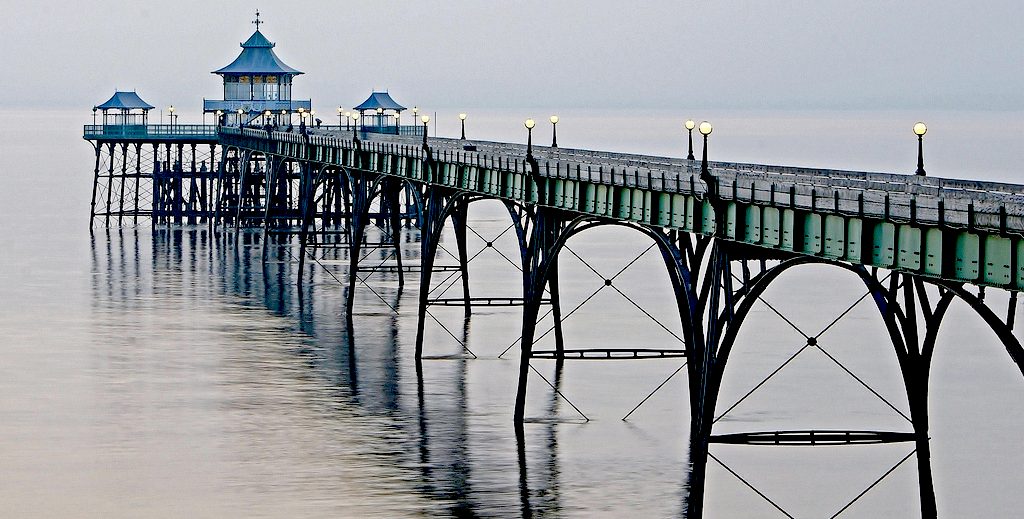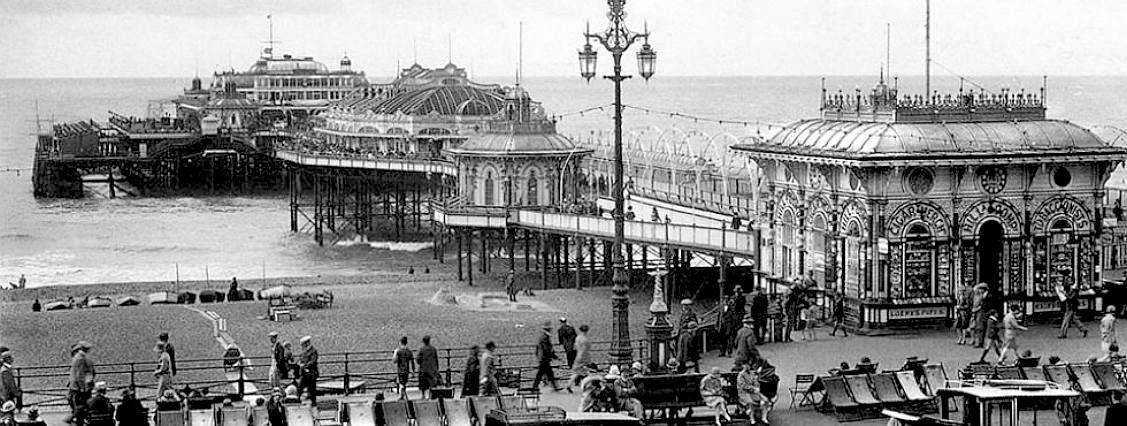|
EUGENIUS
BIRCH

Eugenius Birch (June 20, 1818 – 1884) was a 19th-century English naval architect, engineer and noted pier builder.
Both Eugenius and his brother were born in Gloucester Terrace, Shoreditch, to grain dealer John and wife Susanne. Fascinated by engineering from a young age, while still a boy he submitted a design for a passenger carriage to the London and Greenwich Railway company. His innovation was to place the wheels beneath the carriage as opposed to the side, freeing more room for the passengers.
As a result, aged 16 he joined Bligh’s engineering works in Limehouse as an apprentice, and then studied at the Mechanics' Institute. Showing a gift for draftsmanship, aged 19 in 1837 he received a silver Isis Medal from the Society of Arts for his drawing of a marine steam engine, and a second silver medal the following year for his drawings and description of Huddert’s rope machinery. Later in his life, particularly during his travels, Birch produced beautiful watercolour paintings, particularly those of
Italy,
Egypt and Nubia during his winter of 1874–75 tour.
In 1845 he formed a general design engineering partnership with his brother, which worked across various projects including railways, viaducts and bridges, including the Kelham and Stockwith bridges in Nottinghamshire. He also undertook various projects within the British Empire, travelling to
India to advise on the design and construction of the Calcutta to Delhi railway of the East Indian Railway Company.
He also designed the Devon and Somerset Railway, Exmouth docks, Ilfracombe harbour, and West Surrey waterworks.

HASTINGS
PIER - Circa 1905. Designed by Eugenius Birch at a cost of £23,250, it opened on the country's first ever Bank Holiday (Monday, 5th August 1872). The Who,
Jimi Hendrix and the
Rolling Stones were among the bands to play in its ballroom in the 1960's. Tickets were 75 pence.
PIERS
On his return to England, Eugenius brought his global experiences to bear on the developing English fascination with seaside holidays, specifically the construction of piers. With the railways now allowing easy and cheap access to the seaside, and the known health benefits of clean air, businessmen in coastal towns were competing against each other to create the longest and most ornate piers to attract the greatest number of tourists.
In 1853, a group of Margate businessmen approach Birch to build a pier. In its design and construction, he brought two innovations:
* His time spent in India brought about style innovations which were directly influenced from the continent.
* As opposed to the then accepted wooden pile hammering to create the pier, Birch fitted screw blades to his iron piles, to create a deeper and far more resilient base support.
The result was a stylish and resilient Margate Pier, which survived storms and two world wars until a storm in January 1978, while its foundations survive today despite direct attempts at demolition.
The result was a series of new commissions, which eventually ran to 14 piers in total, the most famous of which is the
West
Pier, Brighton. His effect on pier construction techniques can be measured in the fact that, from 1862 to 1872, 18 new pleasure piers were built, the majority using screw piling. His last pier was Plymouth, opened in the year he died, 1884.

MARGATE
PIER - Was also designed by Eugenius Birch

CLEVEDON
PIER - This is one pier that was not designed by Eugenius
Birch, but he was an inspiration to other designers - and in
this case simplicity gave an elegance to a pier that even
Eugenius would have admired.
During the Victorian era, Clevedon became a popular seaside town, having previously been an agricultural village. Due to improving transport links, via the Clevedon Branch Line, Clevedon was able to cater for the late 19th century craze for bathing in the sea with saltwater baths adjacent to the pier (since demolished, though the foundations can still be seen), and bathing machines on the main beach. Many English seaside resorts built piers in the 1850s to attract tourists. At Clevedon tourism grew following the opening of a branch line from Yatton railway station which connected it to the Bristol to Exeter Line, enabling travel from the rest of the country. It was also proposed that a pier could form part of a route from London to South Wales with the use of steamers to cross the Severn Estuary. An enabling act was submitted to parliament in 1864.
On 16 October 1970, spans 7 and 8 of the pier collapsed during stress testing, which had been introduced in the 1950s as a requirement for obtaining insurance cover. The tests involved the placement of polythene tanks 50 ft (15.2 m) long, 5 ft (1.5 m) wide and 2 ft (0.6 m) deep filled to a depth of 10 in (25.4 cm), which created a pressure of 50 psf (2 kPa). This simulated the required load agreed with the Ministry of Transport.
Six tanks were used for each span and left in place for three hours; the 18 tanks used in total allowed three spans to be tested simultaneously. At the end of the three hours the tanks were emptied and dragged along the deck to test further spans. The first six spans passed without problems, but under load the seventh span collapsed, bringing down the eighth and final span, leaving the pier head and pavilion standing.
The Clevedon Pier Preservation Society was formed in 1972 and started campaigning for the restoration of the pier. The district council applied for permission to demolish the pier in 1979, but a public enquiry the following year ruled that it should be retained. The pavilions from the end of the pier were taken ashore in 1982 for storage in anticipation of eventual restoration; insufficient funds were available to complete restoration and the first stage was to open the Toll House as an exhibition centre in 1984.
A major breakthrough came in 1984, when English Heritage and the National Heritage Memorial Fund granted a million pounds towards the restoration, with smaller sums from Woodspring District Council and other funding bodies. The trust, which had been formed by the preservation society, also obtained a 99-year lease. The pier was dismantled in 1985, taken to Portishead dock for restoration, and reconstructed in 1986.
After a long campaign by local people to raise funds for restoration (supported by Sir John Betjeman, who described Clevedon as "the most beautiful pier in England"), the pier eventually reopened. Some funds were raised by "sponsored planks" – small brass plaques with names or messages are inlaid on the wooden planks and benches, recording donations. Reconstruction of the pier spans and decking was completed on 27 May 1989, and the pier was reopened to great enthusiasm. The pierhead was still shut, however, and it was not until 23 May 1998 that it was finally restored and opened to the public, as a result of funding from the Heritage Lottery Fund. In 1999 the National Piers Society awarded Clevedon Pier the title of Pier of the Year, and it also won a Civic Trust Award. The pier was re-designated a Grade 1 listed building in 2001, the only other pier with this status being Brighton's West Pier (largely destroyed by fire and storms between 2002 and 2004).
The landing stage at the end of the pier is used throughout the summer season (June to September) by the Waverley and her sister ship, the Balmoral, and is a popular spot for angling. There is a cafe at the pierhead, and a souvenir shop at the toll house. The upper floor of the toll house is an art gallery with a different exhibition every month. The pier is open every day of the year except Christmas Day. Scenes from the 2010 film, Never Let Me Go, starring Keira Knightley were filmed near Clevedon pier during 2009, and the pier also featured on the promotional posters. One Direction's music video for their single "You & I" was filmed on Clevedon Pier. An appeal was launched in 2012 to raise £1.6 million for a new visitor centre and educational facility, an additional £800,000 of grants have been applied for to cover the cost of repainting the legs of the structure. In December 2012 it was announced that the pier had received £720,000 of funding from the Heritage Lottery Fund to improve the visitor centre.

GONE FOR GOOD - This magnificent pier was Grade I
listed but could not be saved, despite much publicity. The pier gradually collapsed during the early 21st century. Major sections collapsed in late 2002, and two fires in March and May 2003 left little of the original structure. Subsequently, English Heritage declared it to be beyond repair. Structured demolition took place in 2010 to make way for the i360, an observation tower which started construction in
2014.
LIST OF PIERS
DESIGNED BY EUGENIUS BIRCH
* Margate Pier, Margate (1856–57)
* North Pier, Blackpool (1862–63) Contractor R Laidlaw and Son, Glasgow
* West Pier, Brighton (1863–66) (Destroyed in 1975, 2003, 2004) Contractor R Laidlaw and Son, Glasgow
* Deal Pier (1864) Contractor R Laidlaw and Son, Glasgow
* Lytham Pier (1864–65) Contractor R Laidlaw and Son, Glasgow
* Aberystwyth Royal Pier (1865) Contractor JE Dawson
* Eastbourne Pier (1866–72)
* Birnbeck Pier, Weston-super-Mare (1867) (Currently closed to the public)
* [New Brighton Pier] (1867) Contractor JE Dawson
* Scarborough North Pier (1866–69)
* Hastings Pier (1869–72) Contractor R Laidlaw and Son, Glasgow
* Hornsea Pier (1880)
* Bournemouth Pier (1880)
* Plymouth Pier (1884) with CE Daniel Engr
also
* Brighton Aquarium (1869–72)

QUEEN
VICTORIA - An advocate of sea air and coastal attractions,
Queen Victoria gave her name to the period when pier building
was a national pastime, with each new project vying with a neighbor
for tourists.

CONTACTS
Eastbourne Pier Rescue Project
Cleaner
Oceans Club Ltd
Solar
Studios
BN27
1RF
United
Kingdom
Contacts:
Hayley Stebbings (events manager)
Terry Valeriano (events security)
Natasha Lee (sports coach)
Briggette Dusart (events admin)
Tel:
+44 (0) 1323 831727
Email:
pageant@miss-ocean.com

GOOGLE
MAPS - The above is a satellite view from one of the most
famous search engine companies. The snapshot was taken in
September 2015, but still shows the Blue Room intact.
LINKS
Heritage
Lottery Fund
Historic
England
Eastbourne
Borough Council
Big
Lottery Fund Coastal Communities Fund
Telegraph
200-years-of-historic-British-piers-in-pictures
https://www.biglotteryfund.org.uk/ccf
http://www.eastbourne.gov.uk/
http://www.hlf.org.uk/
http://www.historicengland.org.uk/
southeast@HistoricEngland.org.uk
|







